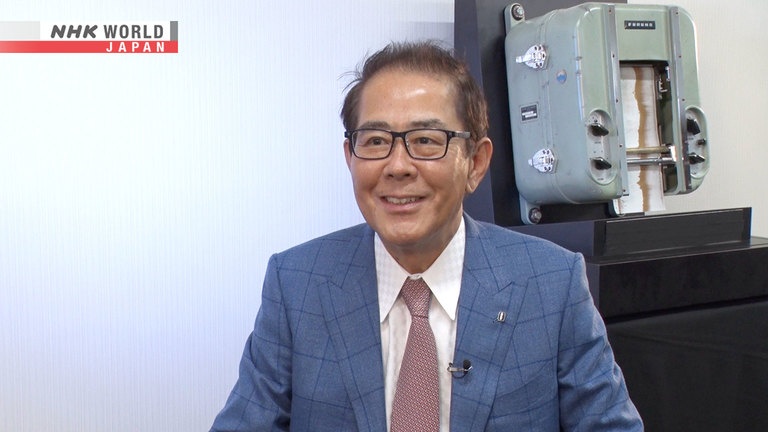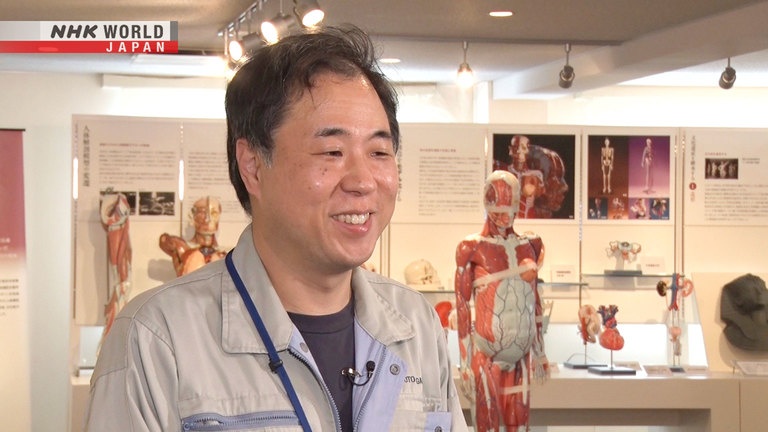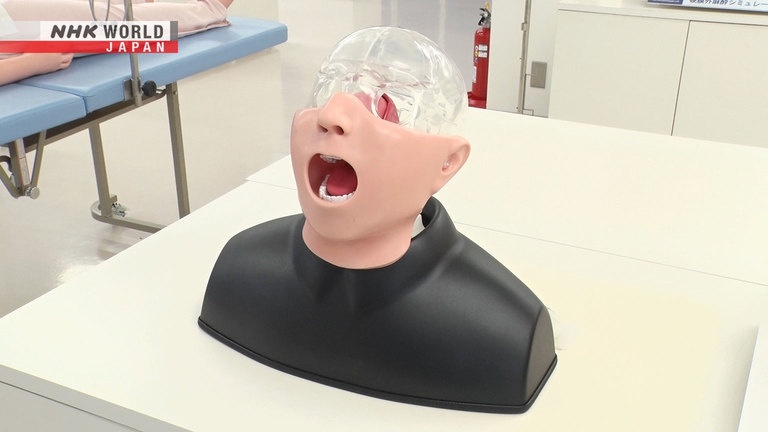Fish Finders / Medical Simulators
The fascinating stories and secrets behind hit Japanese products, plus parts and machines that boast the top share of niche markets. In the first half: the story behind fish finders made by a Japanese company, first used in 1948 and now found in over 80 countries and regions worldwide. In the second half: medical simulators used by medical professionals for training that look and feel real.



Transcript
"Japan's Top Inventions"
The behind-the-scenes tales of hit products and creations from Japan:
this is "Japan's Top Inventions."
On today's show, the fish of the sea.
We tell the story behind a device used on fishing vessels around the world.
Later on the show, models of the human body
which grew in demand during the COVID-19 pandemic.
Can you guess what they're used for?
Hello, welcome to "Japan's Top Inventions."
I'm your host, Jason Danielson.
In the first half of the show, we take you "Behind the Creation."
Today's topic is this:
fish finders, installed on ships.
The device displays the location of schools of fish in the sea.
Knowing where the fish are helps the fishermen net a big catch.
So far, it has been used in over 80 countries and regions,
helping to provide food for people worldwide.
It all started with something the developer heard an experienced fisherman say.
The headquarters of a maritime product manufacturer near Kobe.
Over on the display floor is their latest fish finder.
The red shapes on the display show how big the school of fish is.
You can also tell how far down the fish are.
This is our first fish finder.
This is the fish finder developed by the company in 1947.
The device recorded the location of fish between the surface
and the bottom of the sea onto paper.
Our story begins in 1943.
In a small fishing village in Nagasaki on Kyushu,
a young man was hard at work.
His name was Furuno Kiyotaka, age 22.
Life wasn't easy for Furuno, the eldest of ten siblings.
He dropped out of middle school,
and started a contracting company that did electrical work on fishing vessels.
Koike Muneyuki is the current Vice President of the company that Furuno started.
This is what he heard about that time.
His father was a schoolteacher.
But that kind of salary, a teacher's salary,
it wasn't quite enough to support a big family like the one that they had.
Furuno Kiyotaka was the eldest sibling,
and in order to help, he quit middle school
and decided to start a business.
Then one day,
Furuno was working a job for a very successful fisherman.
The man said something intriguing.
"I can tell where the fish are.
Where there are bubbles, there are fish below."
Fishing was different 80 years ago.
There was no way to peer into the ocean, and see where the fish were.
Fishermen had to rely on their instincts and their experience.
That made Furuno think.
"It's basically a gamble whether you get a catch.
It would be great if you could tell where the fish were from the surface."
He wanted to do something about the inconsistent,
unscientific methods that fishermen were using.
Food was scarce after World War II.
Protein was in high demand.
That meant fish was a vital food source, and there was a need to improve efficiency.
That was how Furuno came up with the idea to make a fish finder.
He readied himself for the path ahead.
Furuno had started developing his idea.
But how would he be able to locate fish from the surface?
No one had made a finder before.
Where would he start?
A piece of navy surplus equipment caught his eye: an echo sounder.
The device measured the time it took for ultrasonic waves
to bounce back from the ocean floor
in order to determine the depth of the water.
Could ultrasound be used to locate fish?
Furuno went straight to an academic who was familiar with ultrasound.
This is what he was told.
"Fish have a lot of water in them.
Ultrasound won't bounce off fish."
I heard that in an experiment, they took some fish, minced the meat,
and then they tried bouncing ultrasound off of it,
but due to the high water content, apparently not much was reflected.
But Furuno remembered what that master fisherman had said,
"Where there are bubbles, there are fish below."
Furuno spent days reading various research papers.
In one of the papers, there was a mention of ultrasound reflecting off bubbles.
If there are air bubbles along the way, some of the ultrasonic waves will bounce back.
This told him that as long as you can receive those waves,
you can find the fish.
And so, using the echo sounder as a reference,
Furuno began prototyping.
And, in April 1947,
his first device was completed.
Would the device actually be able to find fish?
A practical test with the device installed on a ship was needed.
Furuno recruited a fisherman he knew,
and got his younger brother Kiyokata to go along on the ship.
Kiyotaka, the older brother, had come up with the idea.
Kiyokata, the younger one, would work closely with him,
repeating experiments on the boat
and getting the feedback needed to polish up the device.
In order to prove the viability of their fish finder,
a demonstration was needed.
For days, Kiyokata was on the ship,
studying the readouts to see whether fish could be detected.
But the ship generated noise as it moved, and no fish were being found.
Then one day, about one hour after boarding...
There was a faint shadow amidst the noise on the readout.
"We got fish!"
Kiyokata alerted the fisherman right away.
But he was shot down.
"No. There are no fish 'round here."
The fisherman could be very conservative.
There was a faint sign, but it wasn't trusted at first.
But Kiyokata dug his heels in.
"Trust me. Go back."
They returned to the spot that had been recorded, and lowered the net.
Bingo.
Many fish came up.
It was a large school of sardines.
The sensitivity wasn't very high at the time,
so it was just a faint shadow among the noise.
To continue testing on the sea with just that took guts and passion.
And so, for the first time,
Kiyokata was able to catch fish using the fish finder.
His face lit up with a smile aboard the ship.
The Furuno brothers had successfully detected a school of fish using ultrasound.
They were able to bring together science and fishing.
But it was too early to celebrate.
Some unexpected failures would soon spell trouble.
Kiyokata continued testing the fish finder on the fishing vessel.
As he stared at the paper readouts, he spotted a faint shadow once again.
Kiyokata raised the alarm.
"A big school of fish!"
The fisherman lowered the net straight away.
But when he drew it up,
the net was completely filled with round shapes:
jellyfish.
"Your finder is a dud!" the fisherman exclaimed,
and tossed Kiyokata overboard.
Apparently, the device was called fake and a dud,
and he got thrown into the sea.
The performance wasn't so stable back then.
That made it hard to tell whether the readout indicated fish or not.
The problem was the sensitivity of the device.
It needed to better receive the reflected waves
or else it wouldn't accurately detect fish.
The Furuno brothers dedicated themselves to improving the fish finder.
They installed new parts,
and tried many times to boost the sensitivity of the receiver.
They approached development with passion and sincerity.
Even if they got tossed off the ship,
they kept coming back to try again and again.
In May 1949,
a revised model with ten times the sensitivity was completed.
But when they asked fishermen to test it,
they were told, "No. Fish aren't caught by machines."
However, there was one captain who said yes.
One who was famous locally for having the smallest catch among all the fishermen:
Masuda Tomiichiro.
Masuda had previously asked Furuno for some electrical work.
He remembered the fine job that Furuno had done, and agreed to help with the test.
Kiyokata quickly installed the fish finder onto the ship.
But the man in charge of fishing was deeply offended.
"You saying our low ranking is because of me?
Well, I quit!"
Kiyokata ended up on the ship without the lead fisherman.
Desperate, he made a bold move.
He drilled a hole in the center of the ship's underside for the transceiver.
It was part of his plan to increase the sensitivity as much as possible.
If you install it on the side of the ship,
the bubbles created by the ship's movement get picked up.
The underside of the ship has fewer bubbles,
and placing it in the center gives it some protection from other noise.
That would be the best spot for it.
And then, it was time to go fishing.
The ship traveled full speed ahead.
The fish finder was switched on.
They ventured far out in search of fish,
but the readout remained blank.
There was no sign of any fish.
At the time, there wasn't a 100% guarantee you'd find fish.
You could say it was like radioing someone really far away.
You might just barely hear a voice among the noise.
Things weren't looking good.
Kiyokata was crushed.
And that was when it happened.
Shadows suddenly appeared on the readout.
"There's fish!"
The net was cast immediately.
If it was jellyfish again, it would all be over.
Kiyokata held his breath as he stared at the surface.
The water was teeming with life.
It was a large school of sardines and horse mackerel.
For days after,
the ship with the smallest catch continued to break records.
That ship ended up with the number one catch in the area.
By working together,
the brothers were able to make something that made a difference in the world.
I think they both were very proud of their device.
The fish finder had been invented by the Furuno brothers,
and people were finally taking notice of its value.
After that success, fishermen came calling in droves
for the Furuno brothers' fish finder.
It wasn't long before the device came to be used around the world.
How do experts view this invention?
We're joined by Akamatsu Tomonari, to learn more about fish finder technology.
Welcome to the show.
Thank you.
It's been over 70 years since the first fish finders.
What kinds of improvements do the latest devices have?
There are many versions of the fish finder.
Ones that search for fish directly below the ship are common.
Lately, there are advanced ones that can determine the distribution of sizes of the fish,
or approximate numbers, and put that on a graph.
We expect upcoming models, which are still at the research stage,
to even be able to determine the species of fish.
Coming at it from another perspective,
do fish finders increase the risk of overfishing?
Yes.
Fishermen... well, they're hunters.
The first to find a group of fish using a finder will get the bigger catch.
The devices encourage that.
Fishing technologies have advanced tremendously.
If we wanted to, we could catch fish until they went extinct.
That's why fish finders need to become devices that
protect our resources as well.
How are fish finders being used to protect marine resources?
Like if you find a school of fish that is full of big ones,
it's probably OK to catch.
But if there are many small fish, you should leave them another year.
Current fish finders, like the ones that can find out how big the fish are,
allow you to figure that out before you catch the fish.
The fishing industry is on the upswing around the world.
Everyone is learning to like seafood.
If we don't properly manage those natural resources now,
the Pacific, for example, could end up empty.
So fish finder technology is also a useful tool for protecting fish.
We're hoping people use them the right way.
Thank you for your time today. Good speaking with you.
Same here. Thank you very much.
"Top Niche Creations."
Our next segment is "Top Niche Creations."
Today, we're looking at something that helps support medical care around the world.
Medical professionals perform a variety of tasks,
like injections or examinations with tools.
But it's not always possible to practice on a human patient.
That's where something made by a Japanese company
comes in to aid the medical professionals of the world.
They're aiming to provide the realest experience possible.
A manufacturing company in Kyoto.
Inside the company, we find an array of models of the human body.
From full bodies,
to just the upper body.
Even ears.
The company makes over 300 varieties of these kinds of models.
Just what are they used for?
We asked Kageyama Minoru, who is involved with development, to learn more.
We call these medical simulators.
They're devices used for practical training
by students who are trying to become doctors or nurses.
Here is an example.
It's a simulator for diagnosing a patient with a heart condition.
Turn it on, and listen with a stethoscope.
The simulator makes a heartbeat.
If you look carefully, you can even see the pulsing.
This helps students learn how to take a pulse.
You can also change the settings.
There's a noise now.
That's the sound of a patient with a condition called aortic stenosis.
Eighty eight different patterns can be set,
allowing students to practice listening for subtle variations.
And what is this round object?
This is the torso of a pregnant woman.
A probe is readied with gel and placed onto the torso.
An image is displayed on the monitor.
This is a simulator for taking an ultrasound of a fetus.
It looks just like the real thing.
We're shown what's inside.
There's a baby and placenta.
It even has an umbilical cord!
Very realistic.
We try to make it as close as we can.
The most important thing is that realistic training can be done with it.
These simulators allow students to experience success,
to feel like they can do it if they try.
We want doctors and nurses in training to be able to approach patients with confidence.
That's what we are trying to do.
This company is world-famous for their medical simulators.
It was founded in 1948.
They started with anatomical models found in schools.
But in the 80s, the previous president saw something at a nursing school
that made him want to pursue development of simulators.
During a sales visit,
he happened to see students practicing drawing blood with each other.
They were using real needles,
and since they were students, they weren't getting it right in one poke.
They had to do it over and over, and it hurt.
It seemed a bit dangerous,
and he wondered whether there was a better way.
And so, the first simulator they made was for taking blood samples.
They paid careful attention to the materials.
Specially coated silicone was used to replicate the elasticity of skin
when the needle enters.
There's fake blood in here.
A red fluid used in place of blood is injected.
Can you see the red fluid passing through?
Use the needle now,
and you can practice drawing blood just like the real thing.
After the blood sampling simulator, they made models which reproduce sounds,
and ones that can be used for ultrasound or CT scans.
Their products are being used for training by doctors and nurses
in 60 countries and regions worldwide.
Lately, due to the COVID-19 pandemic,
they've increased production of a certain simulator.
This is the one.
It's a simulator for PCR testing.
If the swab comes out with blue, it means a sample was successfully taken.
I believe if our simulators are widely used,
people can worry less about getting good medical care.
We're going to keep developing our products so that
anybody in the world can get quality medical care.
This company also has a product which reproduces the intestines.
This is their large intestine simulator for endoscopy.
Insert the endoscope,
and it's just like the real thing.
If you use too much force, the walls of the simulated intestine will tear.
It's hard to believe just how real they can make it!
That's all for this episode of "Japan's Top Inventions."
We'll leave you with what came next for the fish finders from the first half of the show.
See you next time! And stay inventive.
(Furuno Kiyotaka made the first practical fish finder.)
(The devices have continued to improve.)
(New models can show the distribution and density of the school of fish 360 degrees around the ship.)
(Furuno Kiyotaka passed away in 2013 at age 92.)
(He speaks here in an archival interview.)
I believe that human ingenuity is infinite.
We're not going to suddenly run out of it.
The sea has natural resources.
It's a dream for the 21st century.